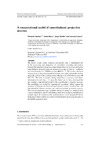A Computational Model of Cuneothalamic Projection Neurons

Ver/
Use este enlace para citar
http://hdl.handle.net/2183/238Coleccións
- Investigación (FCS) [1293]
Metadatos
Mostrar o rexistro completo do ítemTítulo
A Computational Model of Cuneothalamic Projection NeuronsData
2003Cita bibliográfica
Network: computational in neural systems, vol. 14 (2003), p. 211-231
Resumo
[Abstract] The dorsal column nuclei, cuneatus and gracilis, play a fundamental role
in the processing and integration of somesthetic ascending information.
Intracellular and patch-clamp recordings obtained in cat in vivo have shown that
cuneothalamic projection neurons present two modes of activity: oscillatory
and tonic (Canedo et al 1998 Neuroscience 84 603–17). The former is the basis
of generating, in sleep and anaesthetized states, slow, delta and spindle rhythms
under the control of the cerebral cortex (Mari˜no et al 2000 Neuroscience 95
657–73). The latter is needed, during wakefulness, to process somesthetic
information in real time. To study this behaviour we have developed the
first realistic computational model of the cuneothalamic projection neurons.
The modelling was guided by experimental recordings, which suggest the
existence of hyperpolarization-activated inward currents, transient low- and
high-threshold calcium currents, and calcium-activated potassium currents.
The neuronal responses were simulated during (1) sleep, (2) transition from
sleep to wakefulness and (3) wakefulness under both excitatory and inhibitory
synaptic input. In wakefulness the model predicts a set of synaptically driven
firing modes that could be associated with information processing strategies in
the middle cuneate nucleus.
Versión do editor
ISSN
0954-898X





